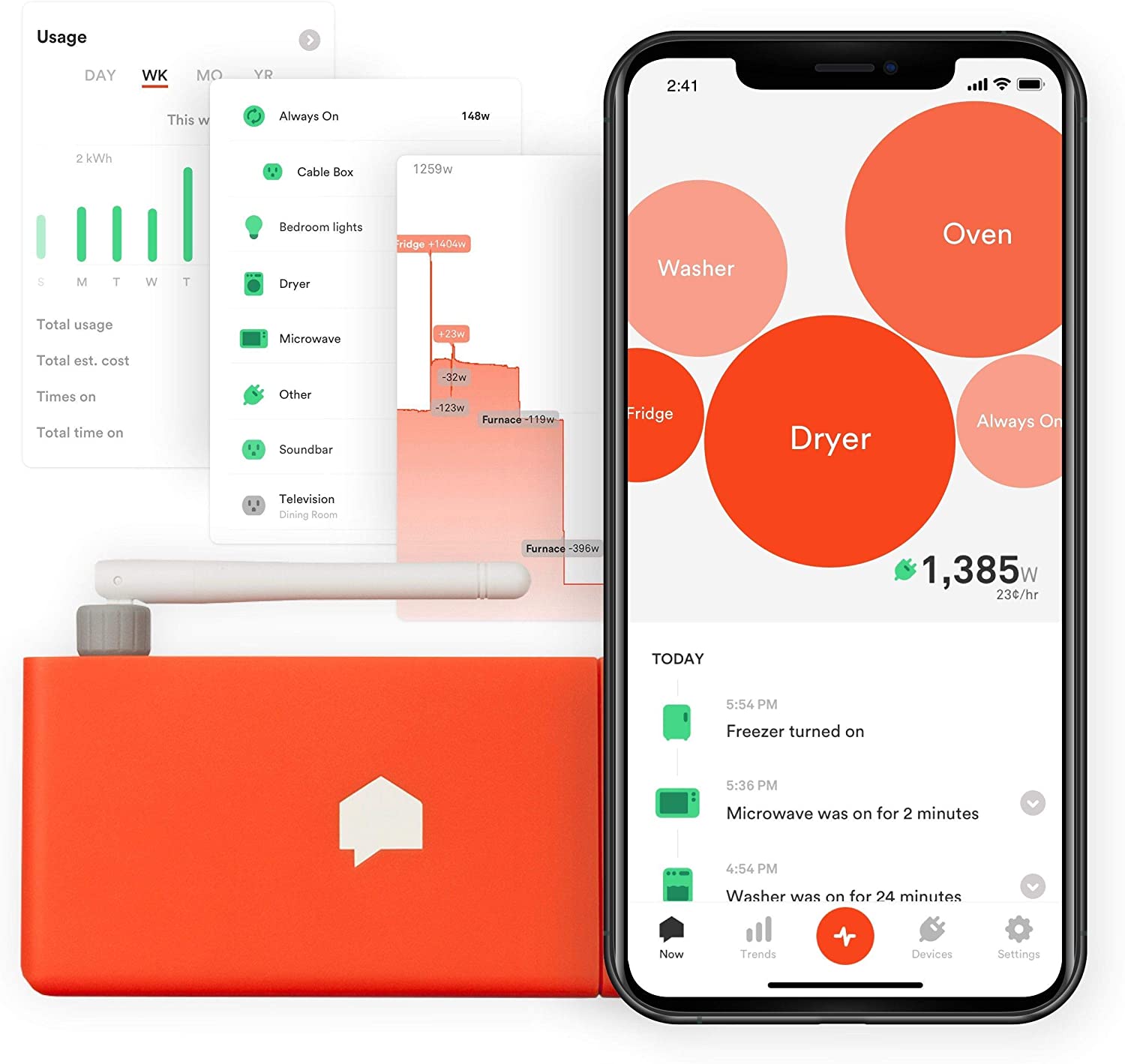The whole-house energy monitor
Whole house energy monitors are just the ticket to getting a detailed understanding of what uses watts in your home. The Sense SM3 is a fantastic product. Read about it here.

It's true what you've heard about me, I have a gadget addiction. How else do you explain multiple computers and nearly 40 devices on my home network? But they all serve a purpose, they provide control and information! Two essential elements in any energy conservation strategy.
You need a Wi-Fi whole-house energy monitor
Well, "need" is probably a bit strong. Let's say you will benefit from one of these marvels. These devices have really evolved since I purchased my first one back in 2010. The mash-up with mobile apps and machine learning gives these babies a lot more capability. Over time, you can begin to get a thorough understanding of what uses watts in your home.
And this understanding is the primary value of these monitors, they provide you with the data needed to make informed energy conservation decisions. You can spot energy hogs; the appliances and equipment that consume more than their share of your energy budget. Root the porkers out and you can take the appropriate corrective measures, thereby saving money!
How is a whole-house monitor better than an appliance monitor?
The original energy monitors were designed to attach directly to a major appliance. You unplugged the appliance, plugged in the monitor and then plugged the appliance into the monitor. Little LCD screens displayed energy use information. Not that the data wasn't useful, it was. However, you could only measure usage for one appliance at a time. Read, record and move to another appliance. Repeat as needed until you cover all of your appliances.
You could buy multiple devices to save a couple of steps in the process. However, you could not measure the big users like your furnace, water heater or central air conditioner. That's why the whole-house monitor is so nice, it covers everything that draws power in your home!
My first device sent information to the Internet (Google Meters, if I recall correctly) where I could watch electricity use in near real-time. I got to the point where I recognized appliances and other energy users by their kW use and the time of day. In addition, the monitor had a neat LCD desktop display. I could watch that and see the power jump when something turned on or off.
When my first monitor shuffled off into the electronic graveyard, I went without a replacement for several months. Fortunately for me, my wife mentioned wanting to know how we used power in our house after seeing us compared to our neighbors. That was all the opening I needed.
Machine learning rocks - ask for it in your energy monitor
After some refresher research, the Sense Energy Monitor Model SM3 caught and held, my attention. It had a slick form factor in an eye-catching orange (yes, that was a decision factor), had a terrific app and used machine learning to identify energy users by the "signature" it generates on your wiring. Amazon had the monitor and delivered it the same day! Woot!
Besides all the forgoing goodies, the SM3 uses machine learning to "listen" to appliances and the "signature" they create on your wiring. While still with the co-op in NJ, I became familiar with the concept, so when I saw it being used, I wanted to see it in action. The simple explanation is that the monitor listens to your appliances, compares their signature to a database and over time, suggests what might be causing the signal. The company says it can take a couple of weeks to start making identifications, but mine started the second day.
Installation cautionary note
This energy monitor, like my first, mounts in or near your electric breakers box. Current transducers clip around the main power feeds and the device is wired directly to a 240-volt breaker and the neutral bar.
Here's the cautionary note:
If you are uncomfortable with or have never worked inside a breaker box, get someone to help with the installation. Even if you are comfortable, follow ALL safety precautions as stated in the instructions.
What you need to install it yourself
You can complete the installation of your monitor with the following:
1. Large flat-blade screwdriver to remove the breaker box cover.
2. Smaller flat-blade screwdriver to secure wires inside the breaker box.
2. Phillips head screwdriver to attach the mounting bracket to a wall (not needed if you mount it inside the box.
3. Hammer to remove a knockout for the antenna cable to pass through.
Figure on spending 30-45 minutes on the installation and another 15 connecting it to your wi-fi network, creating your account and so forth.

My experience
Rather than repeat the excellent installation instructions that came with the product, I will go over what I used as my install was a bit different.
To accommodate my first monitor, I punched out one of the panel's knockouts, so I resued it. Since my panel box is so small, I couldn't mount either device inside. For the new monitor, I mounted it to the wall near the breaker box.
My total installation time took 15 minutes longer because of drilling a hole for the cables to pass through into the breaker box and for a couple of other finishing touches.
Here is the panel box with everything wired up.
1. The current transducers
2. Power wiring

Here is my mounting near the box.
1. The cable leading to the monitor's antenna
2. The Sense SM3 in its wall bracket - no, I didn't mount it upside down!
3. Power and current transducer wiring from the breaker box

Last but not least, here's a screenshot of my Sense app showing the different devices it has identified. The app has a ton of information and tips. It is very cool.

The bottom line
The SM3 energy monitor from Sense has met all my expectations and then some. It took a little juggling to get it connected to my wi-fi network, but that was due to how my network is set up rather than anything with the app.
Sure, it's only been a week, but I like where this is going, especially the way we compare to others. Boo-yah!

